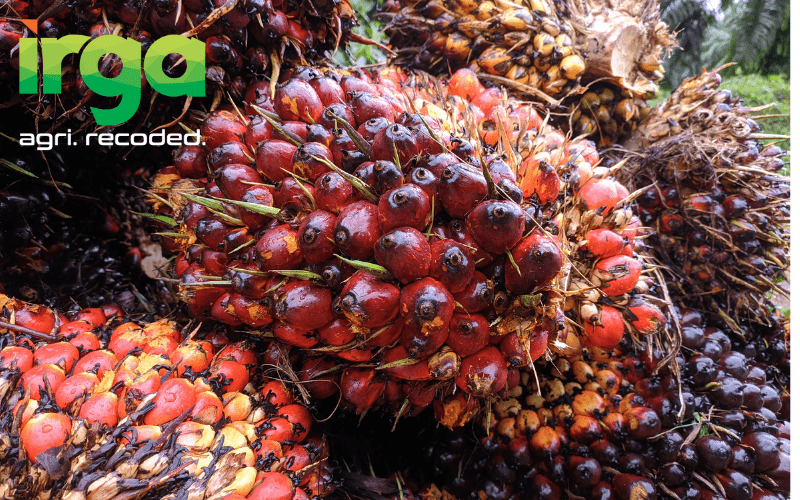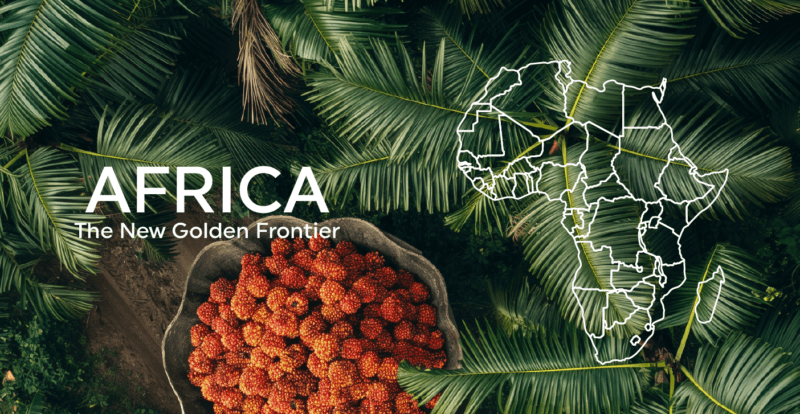
The Dilemma of Labour Shortages in Malaysian Plantations Today
27/03/2024
IRGA and SenzAgro Forge Partnership to Deliver IoT-Driven Precision Agriculture Solutions
24/06/2024The Devastating Effects of Ganoderma and Solutions for the Oil Palm Crop
Introduction
Ganoderma boninsense is a soil born disease affecting oil palm with catastrophic effects. It causes funagal attacks on oil oil palm with what is known as Basal Stem Rot(BSR) as well as Upper Stem Rot. Its destructive consequences can cause up to 43% economic loss in oil palm plantations within six months of its attack.


Ganoderma boninense fruiting body.
What is Ganoderma?
Ganoderma encompasses a group of harmless bracket fungi thriving on deceased wood in natural settings. Among these, Ganoderma boninense specifically targets oil palm, causing disease (as depicted in Figure 1), while also colonizing felled coconut logs and stumps.
Basal stem rot (BSR) stands out as the predominant ailment affecting oil palm, stemming from Ganoderma infection. This condition prompts decay at the palm's base, with the fungus incubating for several years within. The palm typically succumbs or collapses within 4 to 8 years, displaying evident rot (as illustrated in Figure 3). Upper stem rot (USR) refers to Ganoderma's invasion of the upper segments of the oil palm trunk. Occasionally, fungal brackets may manifest, often coinciding with palm fractures at the infected site.

Basal Stem Rot (BSR)
Economically, plantations can still sustainably manage basal stem rot levels up to 20%. However, once levels exceed this threshold, the viability of plantations becomes severely compromised.
Symptoms of the Disease
The decay of wood tissue within the trunk of the palm tree leads to visible symptoms of water stress and gradual decline in frond health. Initially, the infection manifests as yellowing of young fronds, possibly accompanied by unopened spears. Fruiting may cease or yield smaller bunches compared to healthy palms. As the disease progresses through the stem tissue, fronds eventually collapse, halting yield. Typically, the palm succumbs a few months after the onset of these symptoms, often displaying brackets at its base, though occasionally, no brackets are evident on the stem.
Distribution
Basal stem rot poses a significant threat to oil palm plantations, particularly in Indonesia and Malaysia, and more recently in Papua New Guinea and the Solomon Islands. Unfortunately, once the disease takes hold, there are no effective treatments available. In these regions, basal stem rot stands out as the foremost concern among plant diseases. Although it progresses slowly, its prevalence is on the rise.
Initially observed in Malaysia during the 1920s, basal stem rot primarily affected 30-year-old palms nearing the end of their productive lifespan. However, by the 1950s, cases were increasingly reported in palms as young as 10 to 15 years old. Recent surveys have revealed alarming trends, with coastal areas experiencing an average incidence of 30%, and even 2-year-old palms displaying symptoms. The situation echoes in Indonesia, particularly in North Sumatra, where replanting at 25 years sees 40-50% of palms lost, with the majority exhibiting signs of the disease. Similarly, in the Solomon Islands and elsewhere, the prevalence of basal stem rot has been steadily climbing with each replanting cycle.
Monitoring and Examination
Early detection of Ganoderma infection is crucial for effective management. Several signs and symptoms indicate the presence of BSR in oil palm:
- Basal Stem Rot: The most obvious symptom is the rotting of the lower stem of the palm. Infected palms often exhibit a dark brown or black discoloration of the internal tissues.
- Wilting and Leaf Discoloration: Infected palms may show wilting of fronds, which may turn yellow or brown prematurely, or spear leaves that fail to unfurl – signs linked with reduced growth.
- Canopy Thinning: As the disease progresses, the canopy of infected palms may become sparse, with fewer fronds and smaller leaf size compared to healthy palms.
- Presence of Fruiting Bodies: Mature Ganoderma fungi produce distinctive fruiting bodies, commonly known as "conks" or "brackets," which emerge from the trunk or roots of infected palms. These structures vary in size and colour but are typically reddish-brown with a woody texture.
Regular inspection of oil palm plantations has to be carried out, ideally every 3 months.
Management and Control
The management and control strategies of managing Ganoderma in oil palm plantations requires a multifaceted approach that integrates cultural, chemical, and biological control methods. Listed below are some effective strategies for Ganoderma management:
Pre-Planting:
- Stump Removal: It's advised to remove stumps, particularly in Southeast Asia, as the spread of basal stem rot is presumed to occur through root-to-root contact. The decision to employ this method depends on the extent of Ganoderma boninense infection in the previous crop and the labour-intensive nature of stump removal.
- Soil and Water Management: Maintaining optimal soil drainage and avoiding waterlogged conditions can minimize the risk of Ganoderma infection, as the fungus thrives in wet environments
- Clean-Clearing: This involves eliminating the bole and root mass of individual oil palms by excavating a 1.5 square by 60 cm pit at planting points. Debris is shredded, and a legume cover crop is planted to expedite decay.
- Windrowing: Felled oil palm trunks, roots, and leaves are placed in rows among old palms. The material is left un-shredded, but the decay process is accelerated by cutting the trunks into sections. {Note that windrow material may serve as breeding sites for Oryctes rhinoceros beetles).
- Ploughing: Ploughing to a depth of 60 cm, followed by harrowing, reduces root size in areas prone to basal root rot. This process is repeated twice.
- Cover Crops: It's now customary to plant legume cover crops in plantations before or during replanting. Cover crops are essential not only for expediting the decay of Ganoderma-infected trunks but also for nutrient recycling, nitrogen fixation, and weed control.
- Biological Control: Several biological agents, such as Trichoderma spp. and Bacillus spp., have shown potential for suppressing Ganoderma growth. These beneficial microorganisms can be applied to the soil or injected into infected palms to inhibit fungal activity.
- Chemical Treatment: Fungicidal treatments may be used to control Ganoderma in oil palm plantations. However, chemical control should be integrated with other management practices and applied judiciously to minimize environmental impact.
- Resistant Varieties: Planting oil palm varieties that exhibit resistance or tolerance to Ganoderma can help mitigate the impact of the disease. Breeding programs aimed at developing resistant cultivars are ongoing and show promise for long-term management.
During Growth:
- Mounding:Soil is piled around the base of diseased palms to stimulate new root growth and provide support to trees. This is done for all infected trees over 15 years old.
- Trenching:Although a method used in the past, trenching is no longer recommended due to its labour-intensive nature and the lack of maintenance of trenches. Additionally, there is circumstantial evidence suggesting that root-to-root spread may not be the primary means of fungus dissemination.
Resistant Varieties
Differences in resistance between the "dura" and "tenera" varieties exist, and plant breeders are using this to develop palms tolerant to basal stem rot.
Chemical Control
There are no chemicals that can be recommended for commercial or smallholder plantations that would cure the trees once they are infected.
Therefore, enhanced nutritional programmes (ENPs) by using mineral nutrients and plant hormone, appropriate dosage application at seedling stage should be done, in order to make them resistant towards BSR disease when they are transplanted in the field.
Nutritional status of a plant has a major impact on disease resistance. In this regards, optimum nutrient uptake is very important to prevent nutrient deficiency in plants. In general, mineral nutrients are the primary lines of plant defence against pathogens and it is directly influenced by the three components of the plant disease triangle, the hosts, the pathogens and the environmental factors. The mineral nutrients may affect the disease resistance through inducible defences, which includes the production of toxins, metabolites and lignification.

The MPOB Develops a Solution to Control the Palm Oil Stem Rot
The Malaysian Palm Oil Board (MPOB) has introduced a groundbreaking solution to combat Ganoderma disease, which causes upper stem rot in oil palm trees. This innovative treatment involves the use of a systemic hexaconazole fungicide developed by MPOB, effectively tackling the Ganoderma fungus and facilitating the recovery of affected oil palm trees.
In article produced by the NST, Dr. Ahmad Parveez Ghulam Kadir, the Director-General of MPOB, was said to have emphasized the urgent need to address the escalating threat of upper stem rot disease by advocating for the widespread use of hexaconazole fungicide. The technology was initially showcased at the MPOB Transfer of Technology Seminar and Exhibition (TOT) 2021, held virtually in July, in response to the increasing cases of upper stem rot disease.
To apply this treatment, a solution containing 4.5 grams of hexaconazole must be dissolved in three litres of water and administered through trunk injection using a pressure injection apparatus. This process is recommended to be repeated three times at six-month intervals to effectively combat Ganoderma infection.
Dr. Ahmad Parveez has further explained that the fungicide's application could significantly curb the spread of Ganoderma fungus within oil palm plantations, thereby reducing losses attributed to Ganoderma attacks. Apart from chemical fungicides, control measures for both upper and basal stem rot diseases can include sanitation practices to eradicate Ganoderma inoculum sources and the utilization of biological agents such as endophytic or soil microorganisms, degraders, and resistant oil palm materials.
Ganoderma disease has already impacted 221,000 hectares of oil palm estates in Malaysia, leading to an estimated annual loss of approximately RM1.5 billion. With the introduction of this innovative treatment, there is hope for mitigating the devastating effects of Ganoderma disease on the oil palm industry in Malaysia.
Conclusion
How can Ganoderma be eradicated?
There is currently no complete treatment or cure for the disease. So, what can be done to get rid of it?
Apart from treating Upper Stem Rot with hexaconazole fungicide, it is recommended that the infected palm should be removed as soon as possible once the conk(s) appear on the trunk for BSR. Removal of the entire tree, stump and root system is recommended.
It was observed that application of hexaconazole via pressure injection, trunk injection, soil drenching, and soil injection, into diseased oil palms reduced the spread of BSR in the infected oil palms. Pressure injection has been used to accurately apply the hexaconazole to the infected area.
Both Basal Stem Rot (BSR) and Upper Stem Rot caused by Ganoderma present a substantial risk to global oil palm cultivation, impacting both yields and profitability. Yet, with proactive measures and comprehensive control tactics, the adverse effects of Ganoderma can be minimized. Through the adoption of methods such as sanitation, soil upkeep, biological intervention, and the cultivation of resistant strains, oil palm farmers can fortify their plantations against this detrimental fungus.
The immediate concern for farmers, processors, and palm oil-producing countries lies in the sustainability of oil palm cultivation, given the looming threat of Basal Stem Rot (BSR). Ganoderma boninense, by degrading the lignin in oil palm, renders it susceptible to collapse by breaking down cellulose with its array of extracellular enzymes. Understanding how G. boninense achieves this degradation is crucial for devising effective control measures.
Initial infection primarily targets the more accessible carbohydrates, necessitating investigation into inhibiting the involved enzymes. Basidiospores play a pivotal role in the infection process and should not be underestimated. Current control methods have shown limited efficacy, especially as many reports are confined to in vitro or nursery trials with questionable scientific validity. Only a handful of large-scale plantation trials have unequivocally demonstrated disease control, suggesting their suitability for widespread application. Despite promising findings, the translation of research into practical products remains lacking, indicating a need for re-evaluating existing methods. Emphasis should be placed on transitioning leads from laboratory-scale research into consistently effective products.
In concluding, ongoing research and cooperative efforts within the sector are crucial for devising enduring strategies to tackle Ganoderma and secure the enduring sustainability of oil palm production.
References
- Current strategies and perspectives in detection and control of basal stem rot of oil palm , Siddiqui.Y, Surendran.A, et al, Accessed 4//4/2024
- Control of Basal Stem Rot Disease in Oil Palm by Supplementation of Calcium, Copper, and Salicylic Acid, Rahamah.B, Saidu.P, et al, Accessed 6/4/2024
- Control of Basal Stem Rot Disease in Oil Palm by Supplementaiton of Calcium, Copper and Salicyclic Acid, Bivi.M, Paiku.A, et al,National Library of Medicine, Accessed 12/4/2024
- Ganoderma boninense: general characteristics of pathogenicity and methods of control (Updated), Khoo.W, Chong.P, Accessed 1/4/2024
- Ganoderma Control for Smallholder Oil Palm Growers, Pilloti.C, Accessed 8/4/2024
- Labour shortages set up Malaysia for third year of palm oil losses, Reuters, Mei Mei Chu, Accessed 4/3/2024
- MPOB develop solutions to control oil palm top stem rot, NST Business Times, Accessed 10/4/2024
- Pacific Pests, Pathogens, Weeds and Pesticides, Accessed 8/4/2024




